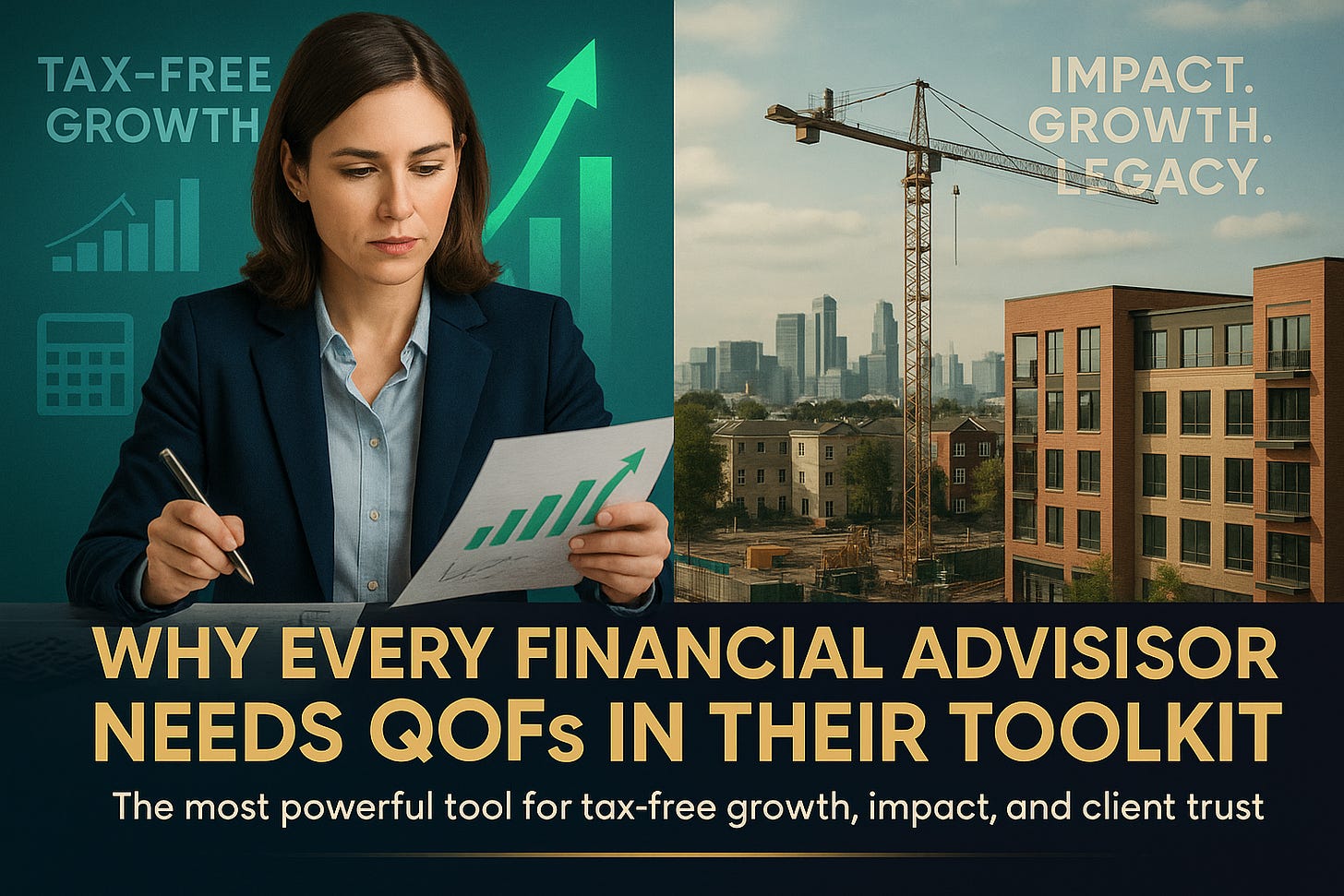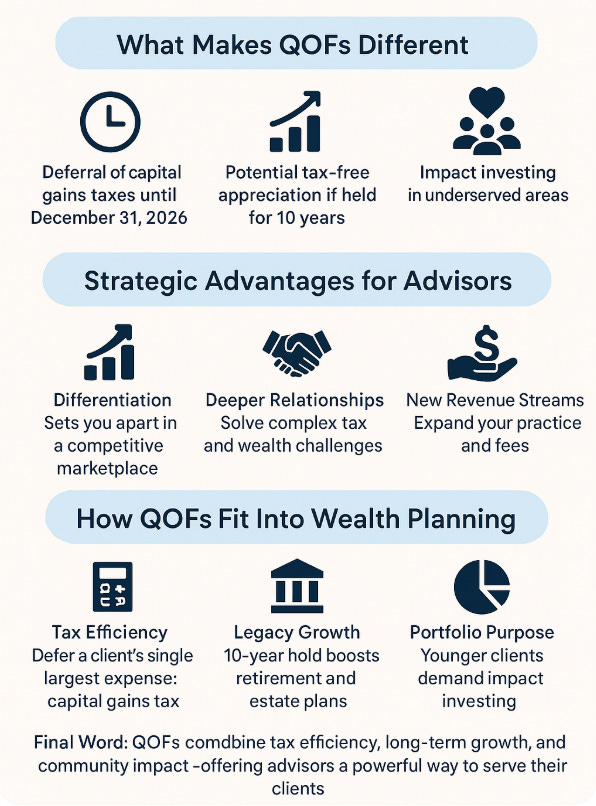Why QOFs Should Be in Every Advisor’s Toolkit
Qualified Opportunity Funds (QOFs) represent one of the most powerful, flexible, and forward-looking planning tools available to financial advisors today.
At the intersection of tax efficiency, long-term wealth creation, and socially impactful investment, they allow advisors to serve client needs on multiple levels. While still underutilized, QOFs provide distinctive advantages that differentiate an advisory practice, deepen client trust, and open the door to a more holistic approach to financial planning.
Lets why QOFs should be considered an essential component in every advisor’s toolkit—covering tax benefits, portfolio alignment, compliance considerations, and their broader role in shaping generational wealth and community revitalization.
Understanding the Basics of QOFs
QOFs were created under the 2017 Tax Cuts and Jobs Act to encourage private capital investment into designated “Opportunity Zones”—economically distressed areas identified by state and federal governments. Investors who roll capital gains into a QOF within 180 days of realizing the gain can achieve three primary benefits:
Tax Deferral – Capital gains invested in a QOF can be deferred until December 31, 2026.
Basis Step-Up – While some benefits phased out in 2021, investors can still eliminate tax on additional appreciation if held for at least 10 years.
Impact Potential – Investments flow into operating businesses, real estate, and infrastructure projects in communities that need revitalization.
For advisors, these features offer a unique intersection of tax strategy, investment growth, and impact investing—making QOFs more than just another tax shelter.
The Strategic Advantages for Advisors
1. Differentiation in a Competitive Market
Few financial advisors have the expertise or confidence to guide clients through Opportunity Zone rules. Those who do stand out as innovators, capable of solving complex tax and wealth planning challenges. By mastering QOF structures, CFAs and CPAs can differentiate their practice, win higher-net-worth clients, and gain referrals from attorneys, estate planners, and other professionals.
2. Deepening Client Relationships
Advisors are constantly seeking ways to demonstrate value beyond portfolio performance. Introducing clients to QOFs shows foresight and a proactive approach. When clients realize that their advisor can help both reduce taxes and invest in meaningful projects, the advisor’s role shifts from “financial manager” to “trusted wealth strategist.”
3. Unlocking Revenue Streams
From a business perspective, QOF structuring and ongoing compliance monitoring can generate new advisory fees. Advisors who partner with QOF specialists or establish in-house expertise can transform this niche into a steady revenue stream.
As Robert Mowry, Partner at Phase Two Ventures, explains:
“Our role is to translate complex Opportunity Zone rules into actionable strategies—so CFAs and CPAs can deliver both financial performance and community impact for their clients.”
How QOFs Fit Into Broader Wealth Planning
Tax Efficiency as a Core Driver
Tax management has always been a critical dimension of wealth planning. QOFs allow clients to capture what is often their single largest expense—capital gains tax—and defer it strategically. For business owners, real estate sellers, or equity investors realizing large gains, this tool can create immediate relief and long-term opportunity.
Long-Term, Tax-Free Growth
Unlike short-term deferral vehicles, QOFs reward patient capital. Holding investments for 10 years allows clients to exit tax-free on appreciation, creating a planning pathway that aligns with retirement timelines, intergenerational transfers, and estate planning strategies. Advisors who frame QOFs within this broader context can show clients how today’s gains become tomorrow’s legacies.
Community and Impact Alignment
Today’s investors—particularly younger generations inheriting wealth—care deeply about impact. QOFs are uniquely positioned to marry tax strategy with social good. By channeling gains into biotech hubs, renewable energy projects, or affordable housing, clients can achieve returns while leaving a tangible community footprint.
As one QOF investor recently noted:
“This isn’t just about deferring taxes—it’s about aligning my portfolio with projects that create real change. It’s wealth with purpose.”
Addressing Advisor Concerns
Compliance and Complexity
One of the primary reasons advisors hesitate to embrace QOFs is compliance. The rules are intricate: satisfying the 90% asset test, tracking eligible projects, and ensuring filings like Form 8996 are accurate. However, this complexity is precisely where advisors add value. By partnering with CPAs and legal experts—or by developing in-house processes—advisors can turn a challenge into a client-facing strength.
Market Risk
QOFs are not risk-free. Real estate projects in underdeveloped zones, or operating businesses in early stages, carry uncertainty. But these risks can be mitigated through due diligence, diversification across zones, and careful alignment with the client’s broader portfolio. This reinforces the advisor’s role in structuring not just any QOF, but the right QOF.
Liquidity Considerations
QOFs often require longer holding periods, making them less liquid than traditional assets. Advisors must educate clients upfront about this trade-off. In many cases, however, the illiquidity matches the client’s goals—retirement, estate planning, or long-term growth—making it a feature, not a flaw.
Practical Framework for Advisors
Advisors can introduce QOFs through a simple four-step process:
Setup – Entity formation, IRS self-certification, and onboarding.
Compliance – Ensuring all reporting standards and tests are met.
Deployment – Directing client capital into vetted projects aligned with their goals.
Monitoring – Providing ongoing governance, updates, and adjustments.
This framework ensures that advisors not only initiate QOF investments but remain actively involved throughout their lifecycle.
Case Study: Transforming a $3M Real Estate Gain
Consider a Los Angeles family that recently sold a property, realizing a $3 million gain. Rather than pay a large tax bill immediately, their CPA introduced a QOF solution. By reinvesting the gain, the family deferred taxes until 2026 while gaining exposure to a biotech-focused Opportunity Zone project.
Ten years later, assuming the investment grows as projected, the appreciation exits tax-free—transforming what would have been a one-time taxable event into a generational wealth engine. For the advisor and CPA, the QOF solution not only saved the client millions in taxes but strengthened a lifelong advisory relationship.
Looking Ahead: The Future of QOFs
The deferral deadline of 2026 is rapidly approaching, but QOFs should not be seen as a temporary strategy. Their role in long-term planning extends well beyond this date. Advisors should prepare for:
Legislative Updates – Congress may extend deadlines or enhance incentives.
Institutional Growth – More funds, platforms, and institutional-grade projects are entering the market, offering advisors better choices.
Intergenerational Planning – As wealth transfers accelerate, QOFs can serve as a bridge between older generations seeking tax relief and younger heirs seeking impact.
QOFs represent a broader movement in wealth management: strategies that combine financial efficiency with community betterment.
Every advisor seeks tools that provide measurable client benefit while reinforcing their professional value. Qualified Opportunity Funds check every box: tax deferral, long-term tax-free growth, and the chance to make an impact. Advisors who adopt QOFs into their planning not only help clients capture overlooked opportunities but also position themselves as leaders in forward-thinking wealth management.
To borrow again from Robert Mowry’s perspective:
“QOFs are not just about deferring taxes until 2026. They’re part of a broader movement toward impact investing, intergenerational wealth planning, and tax-advantaged portfolio management.”
By mastering QOFs, advisors gain more than a tax strategy—they gain a pathway to lasting impact, deeper client trust, and a distinct competitive edge in a crowded marketplace.


